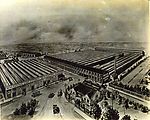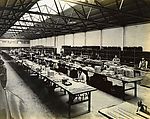 Bird's eye view of the Revo factory in Tipton in the 1920s
Bird's eye view of the Revo factory in Tipton in the 1920s Electrical element winding shop, Revo factory, Tipton, 1928
Electrical element winding shop, Revo factory, Tipton, 1928

The decline of the old export industries during the period between the wars, ran parallel to a growth in new, predominantly consumer industries. While these helped in part to offset the total unemployment figures, the effects were largely regional. Employment opportunities increased most rapidly in Greater London and the Midlands. They did little to ease the plight of those areas where the staple industries, based on coal and iron, had dominated. During the period from1929 to1936 unemployment averaged 20% in the North East, North West and Scotland and over 30% in South Wales. During the same period unemployment stood at 8% or less in the South East and London. Unemployment in 1934 in Coventry was only 5%.
Despite the recession, however, people in work were better off than before. The worldwide economic recession tended to push down food prices on the world market. This did not help farmers in Britain or elsewhere, but it left the bulk of the population in industrial Britain better off.
Lower interest rates in the 1930s, particularly after Britain went off the Gold Standard in 1931, made borrowing easier. Hire purchase became more widespread. This enabled people to buy without cash by putting down a deposit and paying a weekly or monthly amount. All this encouraged the growth of the consumer and retailing industries.
The Central Electricity Board was established in 1926, and with new power came new chemicals, new plastics and new drugs. Technology became more complex and diverse. The demand for white-collar workers and technicians greatly increased.
The new industries, typified by Imperial Chemicals Industries (ICI), domestic appliance and car manufacturers, had different characteristics. The old industries relied on steam power and were heavily dependent on coal. It made sense for them to be near coalfields. Now the new factories could use electricity, which even if produced by coal, enabled much more flexibility of industrial location.
The new industries were not anxious to locate to distressed areas. Although there was a large pool of available labour, the unemployed industrial workers had no experience of the new skills required, and would need expensive re-training. Also, the markets for the sorts of ‘luxury’ goods being manufactured were far away from the distressed areas. The new industries were able to locate nearer to the domestic markets, which in turn accentuated the prosperity of particular regions, and the development of lorries and vans offered new flexibility for moving goods around the country.
Ford’s new factory at Dagenham, Essex, was built in the south-east on a ‘greenfield’ site on the outskirts of London. It had a ready labour force nearby. It was adjacent to London County Council’s largest housing development where, by 1930, 18,000 houses had been built to re-house people from London’s city slums. Ford had a new site, a workforce, accessibility to the sea and the flexibility that comes with electricity. By 1934 it employed 6,000 workers and the numbers had doubled by 1937. More workers were sucked in from other parts of the country.
The Hoover factory was located on the fringes of London, supplied by road rather than rail and was one of the many new factories located round the North Circular Road around London. Hoover was also near the growing markets of the South East of England, where demand grew despite the wider recession. Between 1930 and 1935 the number of vacuum cleaners sold rose almost twelve-fold, from 37,550 to 409,345.
The Revo Electrical Company was established in 1917 in a small production shop on the outskirts of Tipton, in the Black Country. It came to prominence in the 1930s, producing all manner of electrical goods. The factory was vast and employed many hundreds of women, although men continued to be employed in the more traditional jobs in the iron and brass foundry.
The development of mass automated production techniques, especially conveyor belts and assembly lines, became typical of the new industries, especially in electrical engineering, synthetic fibres, food processing, car and materials production. They relied heavily on female workers. Many were young and single, but some had families to support and the new factories did not always impose a marriage bar. Modern companies were employing women at rates, which were higher than could be earned in domestic service, waitressing or small clothing workshops.
The Transport and General Workers’ Union (TGWU), in 1939, evoked the popular, received wisdom on women and the new industries. Women, “ have been found particularly suitable…. Their nimbleness and dexterity in manipulative operations are a great advantage… for example, with women employed in assembling radio sets, where the smallness of their hands in comparison with men gives them an unquestionable advantage in dexterity.”(‘Century of Women’, Rowbotham, p183/184)
Women constituted the main workforce in electrical engineering, which grew from 15.4% of all engineering workers in 1924 to 22.5% by 1935. The General Electrical Company (GEC), for example, became the largest single employer of women in Coventry, a position it continued to hold in the post-war period. Consumption of processed ‘leisure foods’ soared, and women accounted for 70% of the operatives in the biscuit industry, which saw a doubling of production during the inter-war period.
Discipline in the new factories could be strict. At the Electric and Musical Industries' (EMI) factory in Hayes, near London, work started at 7.33 a.m. prompt. Workers were locked out until lunchtime if they arrived late. On the other hand many firms used corporate strategies to retain workers’ loyalty. Hoover, for example, had a resident doctor, its own fire brigade, a canteen and a laundry for overalls.
The conveyor belt proved to be an effective way to impose management control of the labour force; the pace of production could technically be speeded up at will. In one clothing factory, employing 500 girls aged 15 and 16, the system was so speeded up and so exhausting that the manager was forced to introduce a ten-minute rest every hour. ‘Team spirit’ was used effectively in many factories to discipline a worker, since if she failed to keep up the pace the whole group lost bonus. Women considered assembly-line jobs to be ‘plum’ jobs, with pay and benefits generally much higher than in women’s work in general. Nevertheless, complaints over the unyielding use of the conveyor belt were common. Despite there being no trade union tradition in the new industries, resentment of speed-up imposed by rate-fixers and time-study men was at the root of many unofficial, lightning strikes in various factories.
Lucas, a motor components firm in Birmingham saw one of the most influential struggles by women early in 1932. The main instigator was Jessie McCullough. She worked filing shock absorbers, which she described as, ‘rough work even when nobody’s pushing you around.’ One day she found herself being timed. ‘The fact was that I’d always worked quickly…. they obviously wanted to set the time by me, and the others would have to keep up with it.’ (Lesley Stevenson, ‘Women Workers and the New Industries of the 1930s, 2004,) Jessie turned to the TGWU for help. 10,000 women came out on strike. Many of the workers were young girls, who had come from the Black County in droves. With fathers and brothers unable to find work they were the main breadwinners. It took real courage to make a stand and come out on strike. Within a week Lucas had backed down. Some months later, however, Jessie and other activists were laid off and found themselves blacklisted throughout the Birmingham area.
It is clear that although the period between the wars saw the generation of a new form of power, a new generation of workers and a new generation of working practices, the struggle of working people for improved working conditions was set to continue.
Rollover the captions in the box to see the available images in thumbnail format, click the caption to see the full-size image
| Reference: | 756 |
| Keywords: | |
| Archive Ref: | |
| Updated: | Wed 9 Jul 2008 - 10 |
| Interpretation written by | Barbara Harris |
| Author's organisation | |
| Organisation's website |